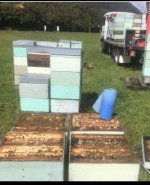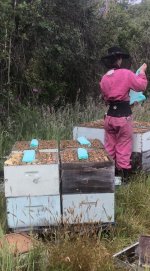We have used O/A strips with great success for the last few years . We work the application of them into our normal routine as we get around the hives every three weeks. Some get chewed out, some don't, so we generally add another two to keep things topped up.
i think thats not a good practise as such. i also disagree with the 3 staples a bit that many use unless its running low amounts of brood.
the reason is simply oxalic breaks down very very fast. its not like chemical strips where the fairly stable chem gets onto the bee and then spread from that bee to other bees. so you can have two strips and the chem gets spread around all the bees easy enough. oxalic is less spreading because it doesn't last, so you need more bees contacting the strips, hence more strips. but also bee activity dictates how much contact the bees get.
so if bees are active on frames that don't have treatment then they don't get treatment. ie you need strips placed in every frame gap that has brood. 8 frames of brood 4 staples (8 strips). dose level is more about strip width.
so adding few strips later doesn't really help, having a few old ones and a few new ones is not good because some will get enough dose, others will get an ineffective dose. when you need all to get an effective dose. 2 new strips is not spread across all the bees, its only going to effect a few of them.
so all strips need to be replaced with new ones.
i suspect some of the issues are caused by oxalic being promoted as cheap and beeks trying to use the less staples they can, instead of error on the side of caution and using the max they can.




